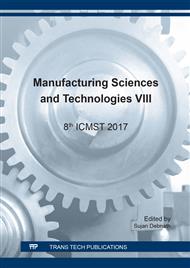p.34
p.39
p.44
p.51
p.56
p.61
p.66
p.71
p.77
Research on Sound Insulation Performance of Poroelastic Material in Complex Structure
Abstract:
A finite element model of the double-wall acoustic insulation structure with a air layer and an acoustic absorbent layer made of the poroelastic materials is set up, the responses of this acoustic-vibration system are calculated by using of the direct finite element method when having a diffuse incident acoustic field acting on the incident surface, the radiant acoustic power from the another surface are achieved, then the Transmission Loss(TL) are formulated using the incident acoustic power and the radiant acoustic power. The effects of the thicknesses, elastic modulus, flow resistivity and viscous lengths of the poroelastic materials on TL are analyzed. The results show that the thicknesses and elastic modulus have a significant effects on TL, TL are enhanced with the thicknesses increasing of the poroelastic materials layers, a 4.9dB addition of TL is achieved when thickness is added from 2cm to 3cm; TL are enhanced with the reduction of the elastic modulus in considered frequency range, and TL are reduced with the declining of viscous lengths and with the addition of the flow resistivity when the frequencies are higher than 600Hz.
Info:
Periodical:
Pages:
56-60
Citation:
Online since:
January 2018
Authors:
Price:
Сopyright:
© 2018 Trans Tech Publications Ltd. All Rights Reserved
Share:
Citation:


